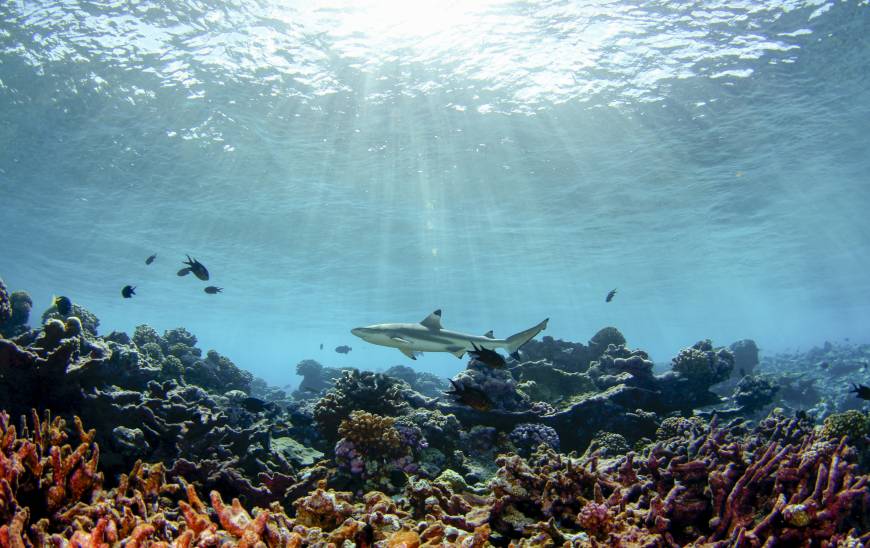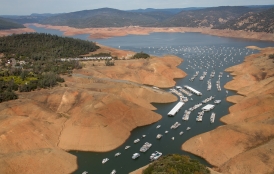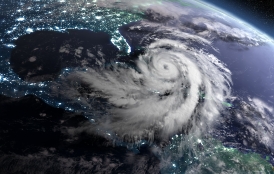The Stanford School of Earth, Energy & Environmental Sciences is now part of the Stanford Doerr School of Sustainability.
This page is currently being maintained for archival purposes only. For the latest information, please visit us here.
Stanford research shows how wave dynamics and water flows affect coral reefs
Understanding what aids or degrades these sensitive ecosystems can help focus conservation efforts on those reefs that are most likely to survive global warming.
By
Elizabeth Svoboda
September 16, 2016

<p>A black tip shark swims above a shallow reef of primarily dead coral skeletons at Palmyra Atoll. Research by Stanford scholars offers new insight into how climate change will affect reefs. (Image credit: Brian Zgliczynski)</p>
While climate change threatens coral reefs in oceans around the world, not all reefs are affected equally. As oceans warm, physical forces like wave strength and water flow influence which reefs thrive and which die, according to a study led by Justin Rogers, a postdoctoral researcher at Stanford’s Environmental Fluid Mechanics Laboratory.
The results, published in a report in the journalLimnology and Oceanography, offer new insight into how climate change will affect reefs on a local level – and also hint at steps conservationists can take to reduce the impact of warming on these fragile ecosystems.
“We have known for a while that high water temperatures are harmful to coral reefs,” Rogers said. “What this paper illuminates for the first time is how waves can lower the water temperature and create better conditions for coral reefs to thrive.”
Coral reefs are among the world’s biodiversity hotspots. They host thousands of marine species to support sustainable fisheries. Their towering structures help to protect vulnerable coastal areas from storm waves. Rogers wanted to understand how forces driving ocean water circulation would affect reef temperatures and, by extension, reef health.
To find out, he and his team deployed a series of instruments in the waters surrounding the South Pacific atoll of Palmyra, including temperature sensors, velocity sensors to track wave speed and pressure sensors to measure the strength of incoming waves and tides. “The idea was just to get a huge coverage over the reef,” Rogers said. After placing the instruments, the researchers monitored them for about three years to collect data.
When Rogers and his team analyzed their atoll data, it became clear that the health of particular reef zones was closely tied to the temperature, wave and pressure dynamics in those areas.
Scientists have long known that rising ocean temperatures affect coral health in a variety of ways. Zooxanthellae – colorful, single-celled algae that live inside coral – ordinarily supply the coral with an abundant food source, and the coral provide shelter for the algae. As ocean water warms, however, stressed corals expel the vibrantly colored algae, exposing the bone-white coral skeleton. Such “bleached” corals are more vulnerable to disease and environmental shocks as a result.
Oceans also absorb more carbon dioxide as temperatures rise, and when this happens, corals are less able to extract calcium carbonate from the water – a mineral they need to form and strengthen their skeletons. As a result, they suffer from stunted growth and may even start to dissolve.
The reefs that did best over time – those showing the highest level of live coral cover – were the ones that received an ample flow of cooler water from the ocean further offshore. The team found that both waves and tides in nearby waters drive the flow rate around these high-performing reefs, with waves being the most significant factor.
“High temperature is very stressful to corals,” Rogers said. “If there’s not enough exchange of water from the open ocean, those areas do not do well.”
Not surprisingly, in reef zones around the atoll that had less moving water, coral cover was much sparser, since there was little cool inflow to offset rising water temperatures.
The researchers also found that coral health suffered when there was high wave stress around the outer edges of reefs – heavy pounding that inflicts physical damage. High wave stress may become more common as climate change proceeds and sea levels rise. Conversely, protected reefs subject to less intense pounding had higher levels of healthy coral cover.
Rogers’ study suggests how coral die-offs in other, similar reefs may proceed if global ocean temperatures continue to rise. A 2016 U.S. government-funded studyreports that oceans are already warming worldwide at an unprecedented rate. If this trend continues, more coral reefs will sicken or die, threatening fisheries in coastal areas and throwing undersea ecosystems off balance.
Reefs in stagnating water zones and those exposed to heavy wave pounding may be among the first to go. “Areas of the reef that are not stressed will suddenly become stressed,” Rogers said. Corals can withstand brief water temperature fluctuations, he added, but their resistance wanes when average temperatures remain high for weeks or months at a time, as they do in areas with low ocean inflow. “What really seems to affect corals are these long-term temperature changes. They create an environment where it’s difficult for the corals to thrive,” he said.
While the prognosis may be grim, Rogers’ findings also suggest practical strategies to salvage as many reefs as possible. “At a local reef scale, we could look at promoting flow in some areas,” he said, though he cautioned that such interventions would have to be vetted carefully to avoid unintended adverse consequences.
But in a warming world, certain reefs may be so severely stressed that they would be unlikely to survive even with help. He suggests that limited conservation funding is best directed to reefs with high ocean inflow, which still have a fighting chance.
“The reefs [with] a better chance of survival are the ones that have a better connection to offshore ocean waters,” he said. “It would be helpful to say, ‘These areas of the reef are going to do better under climate change, so let’s focus our conservation efforts [there].’”
Stanford co-authors with Rogers on the article, “Thermodynamics and hydrodynamics in an atoll reef system and their influence on coral cover,” are Stephen Monismith, David Koweek, Walter Torres and Robert Dunbar.







